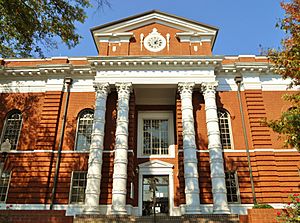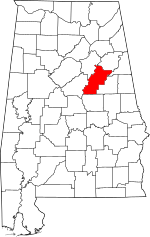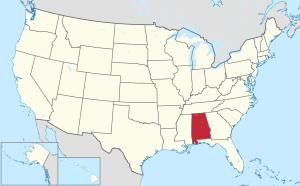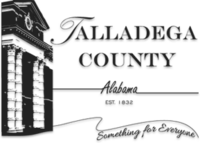Talladega County, Alabama facts for kids
Quick facts for kids
Talladega County
|
||
|---|---|---|

Talladega County Courthouse in Talladega
|
||
|
||
| Motto(s):
"Something For Everyone"
|
||

Location within the U.S. state of Alabama
|
||
 Alabama's location within the U.S. |
||
| Country | ||
| State | ||
| Founded | December 18, 1832 | |
| Named for | Creek for “Border Town” | |
| Seat | Talladega | |
| Largest city | Talladega | |
| Area | ||
| • Total | 760 sq mi (2,000 km2) | |
| • Land | 737 sq mi (1,910 km2) | |
| • Water | 24 sq mi (60 km2) 3.1% | |
| Population
(2020)
|
||
| • Total | 82,149 | |
| • Estimate
(2023)
|
81,132 |
|
| • Density | 108.1/sq mi (41.73/km2) | |
| Time zone | UTC−6 (Central) | |
| • Summer (DST) | UTC−5 (CDT) | |
| Congressional district | 3rd | |
|
||
Talladega County is one of the sixty-seven counties located in the east central portion of the U.S. state of Alabama. As of the 2020 census, the population was 82,149. Its county seat is Talladega.
Talladega County is included in the Talladega-Sylacauga, AL Micropolitan Statistical Area, which is also included in the Birmingham-Cullman-Talladega, AL Combined Statistical Area.
Contents
History
Prior to Euro-American settlement in this area, it was occupied by the Abihka tribe of the Creek Confederacy. The United States forced the Creek to agree to treaties by which they ceded their land to the US, ultimately resulting in Indian Removal to west of the Mississippi River, to Indian Territory.
Talladega County was established on December 18, 1832, from land ceded by the Creek Indians near the state's geographic center. The county seat was established at Talladega in 1834.
The name Talladega is derived from a Muscogee (Creek) Native American word Tvlvteke, from the Creek tålwa, meaning "town", and åtigi, or "border" – "Border Town" – a town indicating its location on the boundary between the lands of the Creek tribe and those of the Cherokee and Chickasaw.
Geography
According to the United States Census Bureau, the county has a total area of 760 square miles (2,000 km2), of which 737 square miles (1,910 km2) is land and 24 square miles (62 km2) (3.1%) is water. It is drained by Choccolocco Creek (archaic spelling: Chockolocko) and other streams. The county is located within the Coosa River Valley and the Ridge-and-Valley Appalachians, with the state's highest point, Mount Cheaha, being located on its northeastern border with Cleburne County.
Adjacent counties
- Calhoun County – north
- Cleburne County – northeast
- Clay County – east
- Coosa County – south
- Shelby County – southwest
- St. Clair County – northwest
National protected area
- Talladega National Forest (part)
Demographics
| Historical population | |||
|---|---|---|---|
| Census | Pop. | %± | |
| 1840 | 12,587 | — | |
| 1850 | 18,624 | 48.0% | |
| 1860 | 23,520 | 26.3% | |
| 1870 | 18,064 | −23.2% | |
| 1880 | 23,360 | 29.3% | |
| 1890 | 29,346 | 25.6% | |
| 1900 | 35,773 | 21.9% | |
| 1910 | 37,921 | 6.0% | |
| 1920 | 41,005 | 8.1% | |
| 1930 | 45,241 | 10.3% | |
| 1940 | 51,832 | 14.6% | |
| 1950 | 63,639 | 22.8% | |
| 1960 | 65,495 | 2.9% | |
| 1970 | 65,280 | −0.3% | |
| 1980 | 73,826 | 13.1% | |
| 1990 | 74,107 | 0.4% | |
| 2000 | 80,321 | 8.4% | |
| 2010 | 82,291 | 2.5% | |
| 2020 | 82,149 | −0.2% | |
| 2023 (est.) | 81,132 | −1.4% | |
| U.S. Decennial Census 1790–1960 1900–1990 1990–2000 2010–2020 |
|||
2020 Census
| Race / Ethnicity (NH = Non-Hispanic) | Pop. 2000 | Pop. 2010 | Pop. 2020 | % 2000 | % 2010 | % 2020 |
|---|---|---|---|---|---|---|
| White alone (NH) | 53,399 | 53,079 | 50,732 | 66.48% | 64.50% | 61.76% |
| Black or African American alone (NH) | 25,206 | 25,953 | 26,340 | 31.38% | 31.54% | 32.06% |
| Native American or Alaska Native alone (NH) | 172 | 230 | 184 | 0.21% | 0.28% | 0.22% |
| Asian alone (NH) | 159 | 329 | 395 | 0.20% | 0.40% | 0.48% |
| Pacific Islander alone (NH) | 20 | 6 | 27 | 0.02% | 0.01% | 0.03% |
| Other race alone (NH) | 35 | 60 | 206 | 0.04% | 0.07% | 0.25% |
| Mixed race or Multiracial (NH) | 518 | 963 | 2,486 | 0.64% | 1.17% | 3.03% |
| Hispanic or Latino (any race) | 812 | 1,671 | 1,779 | 1.01% | 2.03% | 2.17% |
| Total | 80,321 | 80,321 | 82,149 | 100.00% | 100.00% | 100.00% |
As of the 2020 United States census, there were 82,149 people, 30,602 households, and 20,515 families residing in the county.
2010 Census
As of the census of 2010, there were 82,291 people, 31,890 households, and 22,191 families living in the county. The population density was 112 inhabitants per square mile (43 inhabitants/km2). There were 37,088 housing units at an average density of 50 units per square mile (19 units/km2). The racial makeup of the county was 65.3% White, 31.7% Black or African American, 0.3% Native American, 0.4% Asian, 0.0% Pacific Islander, 1.0% from other races, and 1.3% from two or more races. Nearly 2.0% of the population were Hispanic or Latino of any race.
There were 31,890 households, out of which 27.8% had children under the age of 18 living with them; 47.2% were married couples living together, 17.5% had a female householder with no husband present, and 30.4% were non-families. 26.7% of all households were made up of individuals, and 10.1% had someone living alone who was 65 years of age or older. The average household size was 2.48, and the average family size was 2.98.
In the county, the population was spread out, with 23.4% under the age of 18, 8.6% from 18 to 24, 25.8% from 25 to 44, 28.1% from 45 to 64, and 14.1% who were 65 years of age or older. The median age was 39.3 years. For every 100 females, there were 94.9 males. For every 100 females age 18 and over, there were 98.1 males.
The median income for a household in the county was $36,948, and the median income for a family was $44,695. Males had a median income of $38,430 versus $27,404 for females. The per capita income for the county was $18,713. About 15.3% of families and 18.4% of the population were below the poverty line, including 27.1% of those under age 18 and 15.7% of those age 65 or over.
Education
Talladega County Schools is the local school district.
The Birmingham Supplementary School Inc. (BSS, バーミングハム日本語補習校 Bāminguhamu Nihongo Hoshūkō), a part-time Japanese school, has its office at the Honda Manufacturing of Alabama, LLC facility in unincorporated Talladega County, near Lincoln. It holds its classes at the Shelby-Hoover campus of Jefferson State Community College in Hoover. The school first opened on September 1, 2001.
Transportation
Major highways
 Interstate 20
Interstate 20 U.S. Highway 78
U.S. Highway 78 U.S. Highway 231
U.S. Highway 231 U.S. Highway 280
U.S. Highway 280 State Route 21
State Route 21 State Route 34
State Route 34 State Route 76
State Route 76 State Route 77
State Route 77 State Route 148
State Route 148 State Route 202
State Route 202 State Route 235
State Route 235 State Route 275
State Route 275
Rail
- CSX Transportation
- Norfolk Southern Railway
- Amtrak
- Eastern Alabama Railway
Communities
Cities
- Childersburg
- Lincoln
- Oxford (part of Oxford is in Calhoun County)
- Sylacauga
- Talladega (county seat)
Towns
- Bon Air
- Munford
- Oak Grove
- Talladega Springs
- Vincent (part of Vincent is in Shelby County and in St. Clair County)
- Waldo
Census-designated places
Unincorporated communities
- Alpine
- Bemiston (neighborhood in Talladega)
- Chinnabee
- Curry
- Eastaboga (part of Eastaboga is in Calhoun County)
- Fishtrap
- Hopeful
- Kahatchie
- Kentuck
- Laniers
- Liberty Hill
- Mardisville
- Old Eastaboga
- Renfroe
- Sycamore
- Winterboro
Ghost town
See also
 In Spanish: Condado de Talladega para niños
In Spanish: Condado de Talladega para niños


